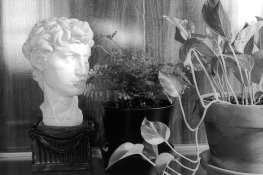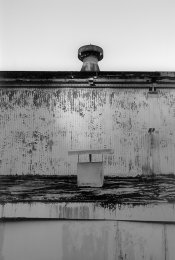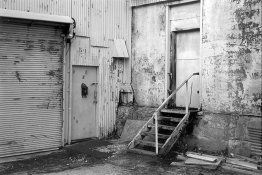I'm always fighting it- but I have teenagers and they're filthy animals.Never heard of that before so no. Dust is not usually a big problem for me.

I'm always fighting it- but I have teenagers and they're filthy animals.Never heard of that before so no. Dust is not usually a big problem for me.

So I guess everyone is scanning this stuff.
You're right though, I haven't seen a single thread on how well it prints (but I haven't conciously looked for one).So I guess everyone is scanning this stuff.
You're right though, I haven't seen a single thread on how well it prints (but I haven't conciously looked for one).
Does this film have the ability to attract massive amounts of dust or does it come that way out of the box? I've never seen film look like this before.
Dust on the film brought with it from the factory and not wiped off at the cassette or dust attracted inside the camera would show up black.
I found the same in many contrasty situations, but in soft light, the ilfosol was on par with HC-110(b).I’ve found the ilfosol3 negs to be lacking in shadow detail and to have some stubbornly blocked up highlights on an LPL45 VC enlarger. Hoping the D96 or ID3 to mitigate this. I never scan film, I only scan from 8x10 prints.
Well I developed my first roll of Ferrania's P30 Alpha film. It didn't go well. Does this film have the ability to attract massive amounts of dust or does it come that way out of the box? I've never seen film look like this before. The film seems very underexposed too but I can live with that. The dust makes these images useless. I emphasize that I've never once see any film I've process come out looking like this before.
Canon 1V, 100-400mm f/4.5-5.6 L II lens, Kodak HC-110, Dilution B, 5 mins @ 20C, 30 seconds of inversion, then 1 every minute.
This is a typical frame.

Just ran two rolls in D96. Shot both at ISO80, after reading that Ferrania is adamant that this is an 80 speed film. Looked at the best practices sheet and read that for D96, the best chemistry for P30, one should shoot it at 50. Ah well. I bracketed anyway.
I use metal reels and tanks. For these rolls I used a single 300mL tank for each.
First roll was 9 minutes, gave 15 seconds of agaitation initially then 1 inversion every ten seconds. Film looked much better than the Ilfosol3 roll, but still pretty contrasty.
Second roll was 11 minutes, gave 15 seconds of agitation initially then 1 inversion every minute. This roll looks very good. I will give this another try with some more film.
Films are in the dryer now, I will get to print some tomorrow and will give some impressions of the negatives in the enlarger and on paper.
I have been reading this entire thread for a few days now. Some fantastic test images shown. Really interesting to see everyone results with different developers, times, etc.
I am keen to swap my kickstarter reward from the colour slide film to this P30 in the next round they allow us to do so I think, especially for some 120 once it's available.
I was thinking while reading all the comments, that it's a shame they have not made some bulk rolls (30.5m or even 17m) of the 135 available to some people so they can carry out lots of testing with developers etc. easily by just rolling some small test rolls for themselves.
I know this is probably a silly reply, but how old is your fixer and do you typically filter it after use? (through a coffee filter or the like)
I often get excess dust and marks like this when I've been lazy and kept using the same fixer for too long and not filtered properly thus it containing lots of particles. Just a thought.
...D-96 works best using constant agitation, it's pH target is 8.5-8.6.
Like Bob, I can't test for pH either, but I mixed up the D-96 with distilled water like I do with all developers. However, I processed the film for 6 mins (about 25% less than the recommend 8 mins) on my Jobo and the negs came out way over-developed; like 2.12 Zone VIII density. I'm going to try slow inversion agitation in a Paterson System 4 tank next. If anybody has any tips to pass along, I'm listening...
 I can feel the fluid flow in the tank. I've never used a Jobo, so maybe that motion causes some overdevelopment. I used 8 minutes in my Rondinax as well, but it's agitation/twisting is like a quick rapid spin of the wheel, wait 1-2 seconds and repeat. I prefer the Jobo 1520 tank used like a Patterson.
I can feel the fluid flow in the tank. I've never used a Jobo, so maybe that motion causes some overdevelopment. I used 8 minutes in my Rondinax as well, but it's agitation/twisting is like a quick rapid spin of the wheel, wait 1-2 seconds and repeat. I prefer the Jobo 1520 tank used like a Patterson.My agitation scheme for constant was like Fred Picker: pick up left hand, invert, put down, pick up with right hand, invert, put down and so on for 8 minutes total. No shaking like a bartenderI can feel the fluid flow in the tank. I've never used a Jobo, so maybe that motion causes some overdevelopment. I used 8 minutes in my Rondinax as well, but it's agitation/twisting is like a quick rapid spin of the wheel, wait 1-2 seconds and repeat. I prefer the Jobo 1520 tank used like a Patterson.
I also have done nothing but use colorperfect inversion so no contrast or tone curves. They looked natural to me.
Yeah, my normal tank agitation is very much like yours, although I add a twisting motion as the tank is inverted. I'll try your method first. I have a Jobo 15xx series tank, but all my Jobo tanks have cog wheels for the lift. I'll use the Paterson and report back.
I shoot very, very little 35mm format and when this film in 120 hits the market I'll be jumping on it. It has a "look" that appeals to me and can't wait to try it out. Maybe I should order some just for an excuse to haul the Contax out and dust it off. JohnW
I am not sure which of the looks of this film which has been developed in various developers according to various regimes and scanned on various scanners appeals to you, but I hope you are able to replicate it.I shoot very, very little 35mm format and when this film in 120 hits the market I'll be jumping on it. It has a "look" that appeals to me and can't wait to try it out. Maybe I should order some just for an excuse to haul the Contax out and dust it off. JohnW



 Should be fun.
Should be fun.| Photrio.com contains affiliate links to products. We may receive a commission for purchases made through these links. To read our full affiliate disclosure statement please click Here. |
PHOTRIO PARTNERS EQUALLY FUNDING OUR COMMUNITY:  |